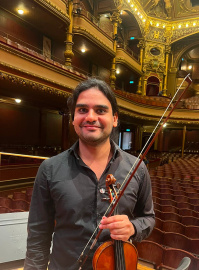Soutenance de thèse Flann Chambers
 |
M. Flann Chambers soutiendra, en vue de l'obtention du grade de docteur ès sciences de la société, mention systèmes d'information, sa thèse intitulée: "Autonomous Generation of a Public Transportation Network by an Agent-Based Model: Mutual Enrichment with Knowledge Graphs for Sustainable Urban Mobility" Date: Jeudi 19 décembre 2024 à 15h00 |
Jury :
- Prof. Giovanna Di Marzo Serugendo, SDS, Université de Genève, co-directrice de thèse
- Prof. Christophe Cruz, Université Bourgogne, co-directeur de thèse
- Dr Camille Bernard, Laboratoire d’Informatique de Grenoble, Université de Grenoble
- Prof. Anthony Lehmann, Institut des Sciences de l’Environnement (ISE), Université de Genève
- Prof. Jean-Henry Morin, SDS, Université de Genève, président du jury
Abstract :
This thesis develops agent-based models of land cover change and mobility inside the canton of Geneva, and demonstrates that, given the establishment of dedicated infrastructure, agent-based models become self-adaptive digital twins of urban systems, which foster communication around its inner workings, state and future trajectories among a wide variety of audiences, and provide valuable guidance for policy-making.
Working towards the sustainability of our cities is one of the greatest challenges of this century, and its assessment requires the development of tools dedicated to holistically capturing the complexity of such urban systems. It is not sufficient to analyse separately each of their components (such as urban mobility, land cover change, etc.), because the interactions between these components are of capital importance to the evolution of the system as a whole.
Agent-based models are highly capable at integrating key characteristics of these complex systems, such as individual behaviours and population heterogeneity, and hold great value in the eyes of policy-makers in their ability to provide insights for decision-making processes. However, research in the agent-based modelling field has encountered a wide array of hurdles, ranging from its data hungriness, and the lack of standardised infrastructure for real time incorporation of real-world data, to drowning out the user in a wealth of parameters to calibrate and output data to visualise efficiently.
In this thesis, we develop three models of urban mobility, commuting patterns and land cover change due to urban expansion, for the canton of Geneva and the Greater Geneva region. We identify four major shortcomings of the current state of the art in the agent-based modelling field and show that our studies adequately address them.
The first model, of commuting patterns along the Cornavin-Meyrin-CERN axis, showcases the capability of agent-based models to capture population heterogeneity, by customising the commuter agents’ timetables based on their age class. The results show that decreasing public transportation offer will drastically deteriorate the commuting experience, with overcrowded trams preventing the boarding of many passengers along this axis. Conversely, increasing the public transportation offer will dampen the influx of commuters caused by the emergence of a new residential district.
The second study harnesses a DPSIR analysis of residential choices based on public transportation offer in the canton of Geneva. Results show that people would rather relocate in homes that are closer to the city centre, and that when this preference is denied by high rent prices and low housing availability, priority shifts to residences located near modes of public transportation with high passenger capacity and travelling speed.
In the third study, we coupled an agent-based model with an ontology and knowledge graphs for representing the history and future of public transportation network development in the Greater Geneva region. The model is able to replay the development of the tram line network, predict future tram line extensions and generate an artificial network from scratch, by building tram lines based on the existing road network and the spatial distribution of the population and aiming to maximise the amount of people reached by the tram lines. Results show that the artificially generated networks closely resemble their real-world counterpart, and both the knowledge graphs and the agent-based model are enriched by the outputs of their consort.
This thesis highlights the strengths of agent-based models in capturing the complexity and emergent phenomena of urban systems. These models integrate the heterogeneity of populations, individual behaviours, and enable the exploration of various hypothetical scenarios, providing valuable insights for policy-making. The works conducted during this thesis make use of additional techniques, such as the DPSIR framework for supporting the establishment of evidence-based model evolution rules, and knowledge graphs, for enhancing communication about the research paradigm among project members and other audiences (such as the general public), as well as for streamlining the design of hypothetical scenarios to explore in the model.
This thesis also addresses four major hurdles that hamper the widespread use of agent-based models in the researcher community as well as for guiding policy-making. The data hungriness of such models is solved by advocating for the establishment of large geomatic databases in open access for the studied system. Decoupling the visualisation of agent-based models’ results, a computationally intensive yet crucial process for unlocking the full powers of such models, from the simulation course, leads to the creation of standalone data exploration platforms. Their deployment to web applications further fosters an efficient communication of these results. Coupling agent-based models with knowledge graphs greatly simplifies the model’s parametrisation process and the design of scenarios, and unifies project members around a common vocabulary and grammar ruleset. Real-time integration of real-world data allows agent-based models to function as self-adaptive digital twins, monitoring the state of the system and its key indicators, predicting its future evolution and allowing for the exploration of hypothetical scenarios. With these barriers lifted, this new generation of "agent-based digital twins" provides a goldmine of insights for guiding political decision-making processes, and helps shape the sustainable cities of tomorrow.
